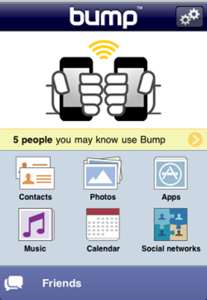
Last year, when a friend and I went to buy our first iPhones, the first thing we went out and downloaded was Bump – the app that lets you share simply by bumping your phone into another one. It seemed like magic. At the time, however, it was only meant for sharing contact information and it soon made its way to the back of our app screens before eventually disappearing off our phones.
These days, Bump is much more than simply a magic app to share your phone number and email address and today we got a chance to sit down with Bump co-founder and CEO David Lieb to talk about where the app has gone and where it’s headed to next.
Bump: An App to Fall in Love With, Again

First of all, if you haven’t seen Bump lately, we highly recommend you give it a download and a second go around the block. It still has the magical bump action (and fun conversational innuendo) as ever at its heart, but it’s gone well beyond simple contact sharing. Bump can let two people share photos, calendar events, app recommendations and music and even quickly let you compare connections and follow each other on Facebook, Twitter and LinkedIn. It will even let you message other people so you don’t have to worry about SMS fees. (If you’re a cheapskate like me, that is.)
Coming Soon to an Android Near You
According to Lieb, Bump is one of the most popular apps in the Apple App Store ever and has been downloaded more than 31 million times since it was first released two years ago. Right now, the advanced version of Bump described above is available on iOS, while Android still has music, contacts, photos, and app sharing – no social networks or calendar sharing. Photos sharing is, however, “by far the biggest feature,” said Lieb, with between a half a million and a million photos going through their servers on any given day. The second most popular feature, app recommendations, should be making its way to Android possibly by the end of the week, as Lieb said they are working hard to get a new version of the Android app into the market.
While the Android app is just catching up with the iPhone app, Lieb said that both will be adding more quickly, with a general goal of getting access to share everything accessible to users via Bump. Beyond that, however, Bump will start interacting in ways it hasn’t yet.
Bumping with People, Places & Things
Beyond adding more sharing features to Bump, Lieb explained that Bump will be expanding beyond person-to-person interaction.
“Another big area … is taking bump beyond just mobile phones and letting you use bump not just in a person-to-person interaction but in a person-to-place or person-to-merchant or person-to-object interaction,” said Lieb. “There’s no reason bump has to run on an iPhone, it can run on lots of pieces of hardware.”
While mobile payments seem like an obvious direction for Bump to move in, Lieb said they were focused on more than just payments.
“NFC is this huge story these days – Google’s built it in to one of their phones – and the first thing people talk about is payments. We see payments as interesting but it’s not really solving a problem I have as a consumer or a problem that a merchant has selling stuff,” he said.
Lieb couldn’t offer much in the way of specifics he said that would could expect some announcements later this year, with new features rolling out in the summer and fall.
Right now, said Lieb, “these other types of interactions are more valuable because I can’t walk into a coffee shop and have the menu pop up on my phone and let me order and pay. I can’t do that today. Those interactions that you can’t do yet are going to be the ones that drive these types of connection technologies.”
Bump is currently available for both iPhone and Android with an update to the Android version coming as early as the end of this week.

















